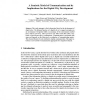Free Online Productivity Tools
i2Speak
i2Symbol
i2OCR
iTex2Img
iWeb2Print
iWeb2Shot
i2Type
iPdf2Split
iPdf2Merge
i2Bopomofo
i2Arabic
i2Style
i2Image
i2PDF
iLatex2Rtf
Sci2ools
AUSAI
2001
Springer
2001
Springer
A Semiotic Model of Communication and Its Implications for the Digital City Development
This study attempts to find a theoretical basis for the development of digital cities. The ultimate function of a digital city is to support navigation in an environment. Navigation builds on meanings of the environment resulted from semiosis processes. These processes may affect each other when combined so that become able to communicate. Communication is performed with signs and depends on the behavioral co-ordination of communicating parties. The classical theories do not satisfactory explain communication. The paper introduces a new model of communication appropriate for computer treatment.
Artificial Intelligence | AUSAI 2001 | Digital Cities | Satisfactory Explain Communication | Semiosis Processes |
| Added | 28 Jul 2010 |
| Updated | 28 Jul 2010 |
| Type | Conference |
| Year | 2001 |
| Where | AUSAI |
| Authors | Victor V. Kryssanov, Masayuki Okabe, Koh Kakusho, Michihiko Minoh |
Comments (0)

